SpringBoot的starter到底是什麼?
前言
我們都知道,Spring的功能非常強大,但也有些弊端。比如:我們需要手動去設定大量的引數,沒有預設值,需要我們管理大量的jar包和它們的依賴。
為了提升Spring專案的開發效率,簡化一些設定,Spring官方引入了SpringBoot。
當然,引入SpringBoot還有其他原因,在這裡就不過多描述了。
本文重點跟大家一起聊聊SpringBoot的starter機制,因為它太重要了。
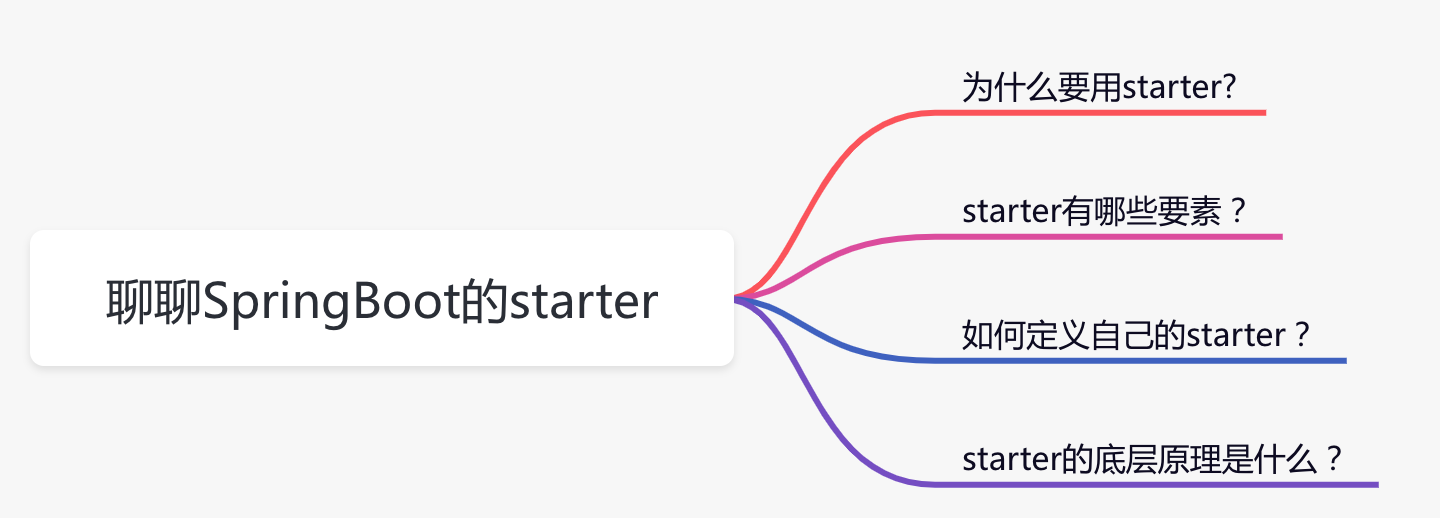
1 為什麼要用starter?
在SpringBoot還沒有出來之前,我們使用Spring開發專案。如果程式需要連線資料庫,我們一般會使用Hibernate或Mybatis等ORM框架,這裡我以Mybatis為例,具體的操作步驟如下:
- 到maven倉庫去找需要引入的mybatis jar包,選取合適的版本。
- 到maven倉庫去找mybatis-spring整合的jar包,選取合適的版本。
- 在spring的applicationContext.xml檔案中設定dataSource和mybatis相關資訊。
當然有些朋友可能會指正,不是還需要引入資料庫驅動包嗎?
確實需要引入,但資料庫驅動有很多,比如:mysql、oracle、sqlserver,這不屬於mybatis的範疇,使用者可以根據專案的實際情況單獨引入。
如果程式只是需要連線資料庫這一個功能還好,按上面的步驟做基本可以滿足需求。但是,連線資料庫可能只是龐大的專案體系中一個環節,實際專案中往往更復雜,需要引入更多的功能,比如:連線redis、連線mongodb、使用rocketmq、使用excel功能等等。
引入這些功能的話,需要再把上面的步驟再重複一次,工作量無形當中增加了不少,而且有很多重複的工作。
另外,還是有個問題,每次到要到maven中找合適的版本,如果哪次找的mybatis.jar包 和 mybatis-spring.jar包版本不相容,程式不是會出現問題?
SpringBoot為了解決以上兩個問題引入了starter機制。
2 starter有哪些要素?
我們首先一起看看mybatis-spring-boot-starter.jar是如何定義的。

可以看到它的META-INF目錄下只包含了:
- pom.protperties 設定maven所需的專案version、groupId和artifactId。
- pom.xml 設定所依賴的jar包。
- MANIFEST.MF 這個檔案描述了該Jar檔案的很多資訊。
- spring.provides 設定所依賴的artifactId,給IDE使用的,沒有其他的作用。
注意一下,沒有一行程式碼。
我們重點看一下pom.xml,因為這個jar包裡面除了這個沒有啥重要的資訊
<?xml version="1.0" encoding="UTF-8"?>
<project xmlns="http://maven.apache.org/POM/4.0.0" xmlns:xsi="http://www.w3.org/2001/XMLSchema-instance" xsi:schemaLocation="http://maven.apache.org/POM/4.0.0 http://maven.apache.org/xsd/maven-4.0.0.xsd">
<modelVersion>4.0.0</modelVersion>
<parent>
<groupId>org.mybatis.spring.boot</groupId>
<artifactId>mybatis-spring-boot</artifactId>
<version>1.3.1</version>
</parent>
<artifactId>mybatis-spring-boot-starter</artifactId>
<name>mybatis-spring-boot-starter</name>
<dependencies>
<dependency>
<groupId>org.springframework.boot</groupId>
<artifactId>spring-boot-starter</artifactId>
</dependency>
<dependency>
<groupId>org.springframework.boot</groupId>
<artifactId>spring-boot-starter-jdbc</artifactId>
</dependency>
<dependency>
<groupId>org.mybatis.spring.boot</groupId>
<artifactId>mybatis-spring-boot-autoconfigure</artifactId>
</dependency>
<dependency>
<groupId>org.mybatis</groupId>
<artifactId>mybatis</artifactId>
</dependency>
<dependency>
<groupId>org.mybatis</groupId>
<artifactId>mybatis-spring</artifactId>
</dependency>
</dependencies>
</project>
從上面可以看出,pom.xml檔案中會引入一些jar包,其中除了引入spring-boot-starter,之外重點看一下:mybatis-spring-boot-autoconfigure。
我們找到mybatis-spring-boot-autoconfigure.jar檔案,開啟這個檔案。
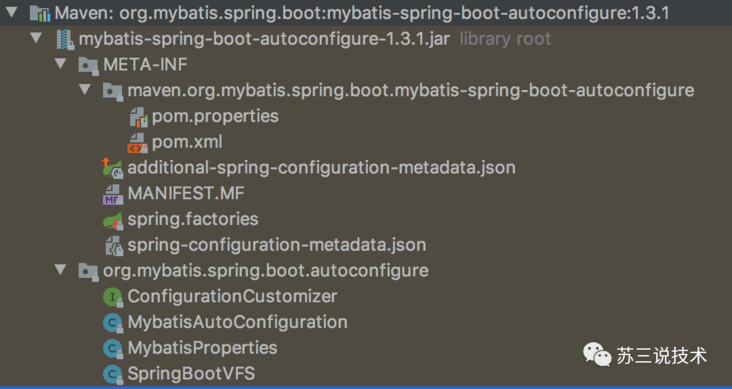
裡面包含如下檔案:
- pom.properties 設定maven所需的專案version、groupId和artifactId
- pom.xml 設定所依賴的jar包
- additional-spring-configuration-metadata.json 手動新增IDE提示功能
- MANIFEST.MF 這個檔案描述了該Jar檔案的很多資訊
- spring.factories SPI會讀取的檔案
- spring-configuration-metadata.json 系統自動生成的IDE提示功能
- ConfigurationCustomizer 自定義Configuration回撥介面
- MybatisAutoConfiguration mybatis設定類
- MybatisProperties mybatis屬性類
- SpringBootVFS 掃描巢狀的jar包中的類
spring-configuration-metadata.json和additional-spring-configuration-metadata.json的功能差不多,我們在applicationContext.properties檔案中輸入spring時,會自動出現下面的設定資訊可供選擇,就是這個功能了。
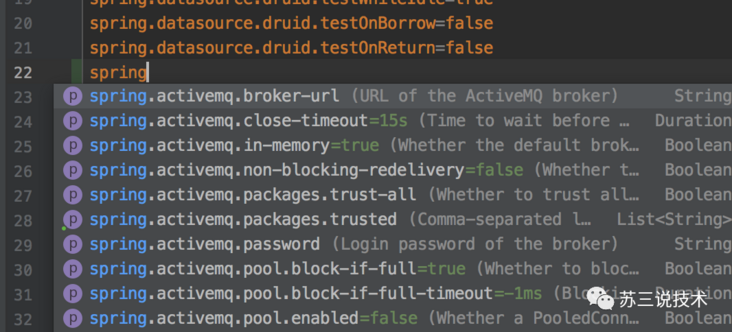
來自靈魂的一問:這兩個檔案有什麼區別?
答:如果pom.xml中引入了spring-boot-configuration-processor包,則會自動生成spring-configuration-metadata.json。
如果需要手動修改裡面的後設資料,則可以在additional-spring-configuration-metadata.json中編輯,最終兩個檔案中的後設資料會合併到一起。
MybatisProperties類是屬性實體類:
@ConfigurationProperties(prefix = MybatisProperties.MYBATIS_PREFIX)
public class MybatisProperties {
public static final String MYBATIS_PREFIX = "mybatis";
private String configLocation;
private String[] mapperLocations;
private String typeAliasesPackage;
private String typeHandlersPackage;
private boolean checkConfigLocation = false;
private ExecutorType executorType;
private Properties configurationProperties;
@NestedConfigurationProperty
private Configuration configuration;
public String getConfigLocation() {
return this.configLocation;
}
public void setConfigLocation(String configLocation) {
this.configLocation = configLocation;
}
@Deprecated
public String getConfig() {
return this.configLocation;
}
@Deprecated
public void setConfig(String config) {
this.configLocation = config;
}
public String[] getMapperLocations() {
return this.mapperLocations;
}
public void setMapperLocations(String[] mapperLocations) {
this.mapperLocations = mapperLocations;
}
public String getTypeHandlersPackage() {
return this.typeHandlersPackage;
}
public void setTypeHandlersPackage(String typeHandlersPackage) {
this.typeHandlersPackage = typeHandlersPackage;
}
public String getTypeAliasesPackage() {
return this.typeAliasesPackage;
}
public void setTypeAliasesPackage(String typeAliasesPackage) {
this.typeAliasesPackage = typeAliasesPackage;
}
public boolean isCheckConfigLocation() {
return this.checkConfigLocation;
}
public void setCheckConfigLocation(boolean checkConfigLocation) {
this.checkConfigLocation = checkConfigLocation;
}
public ExecutorType getExecutorType() {
return this.executorType;
}
public void setExecutorType(ExecutorType executorType) {
this.executorType = executorType;
}
public Properties getConfigurationProperties() {
return configurationProperties;
}
public void setConfigurationProperties(Properties configurationProperties) {
this.configurationProperties = configurationProperties;
}
public Configuration getConfiguration() {
return configuration;
}
public void setConfiguration(Configuration configuration) {
this.configuration = configuration;
}
public Resource[] resolveMapperLocations() {
ResourcePatternResolver resourceResolver = new PathMatchingResourcePatternResolver();
List<Resource> resources = new ArrayList<Resource>();
if (this.mapperLocations != null) {
for (String mapperLocation : this.mapperLocations) {
try {
Resource[] mappers = resourceResolver.getResources(mapperLocation);
resources.addAll(Arrays.asList(mappers));
} catch (IOException e) {
// ignore
}
}
}
return resources.toArray(new Resource[resources.size()]);
}
}
可以看到Mybatis初始化所需要的很多屬性都在這裡,相當於一個JavaBean。
下面重點看一下MybatisAutoConfiguration的程式碼:
@org.springframework.context.annotation.Configuration
@ConditionalOnClass({ SqlSessionFactory.class, SqlSessionFactoryBean.class })
@ConditionalOnBean(DataSource.class)
@EnableConfigurationProperties(MybatisProperties.class)
@AutoConfigureAfter(DataSourceAutoConfiguration.class)
public class MybatisAutoConfiguration {
private static final Logger logger = LoggerFactory.getLogger(MybatisAutoConfiguration.class);
private final MybatisProperties properties;
private final Interceptor[] interceptors;
private final ResourceLoader resourceLoader;
private final DatabaseIdProvider databaseIdProvider;
private final List<ConfigurationCustomizer> configurationCustomizers;
public MybatisAutoConfiguration(MybatisProperties properties,
ObjectProvider<Interceptor[]> interceptorsProvider,
ResourceLoader resourceLoader,
ObjectProvider<DatabaseIdProvider> databaseIdProvider,
ObjectProvider<List<ConfigurationCustomizer>> configurationCustomizersProvider) {
this.properties = properties;
this.interceptors = interceptorsProvider.getIfAvailable();
this.resourceLoader = resourceLoader;
this.databaseIdProvider = databaseIdProvider.getIfAvailable();
this.configurationCustomizers = configurationCustomizersProvider.getIfAvailable();
}
@PostConstruct
public void checkConfigFileExists() {
if (this.properties.isCheckConfigLocation() && StringUtils.hasText(this.properties.getConfigLocation())) {
Resource resource = this.resourceLoader.getResource(this.properties.getConfigLocation());
Assert.state(resource.exists(), "Cannot find config location: " + resource
+ " (please add config file or check your Mybatis configuration)");
}
}
@Bean
@ConditionalOnMissingBean
public SqlSessionFactory sqlSessionFactory(DataSource dataSource) throws Exception {
SqlSessionFactoryBean factory = new SqlSessionFactoryBean();
factory.setDataSource(dataSource);
factory.setVfs(SpringBootVFS.class);
if (StringUtils.hasText(this.properties.getConfigLocation())) {
factory.setConfigLocation(this.resourceLoader.getResource(this.properties.getConfigLocation()));
}
Configuration configuration = this.properties.getConfiguration();
if (configuration == null && !StringUtils.hasText(this.properties.getConfigLocation())) {
configuration = new Configuration();
}
if (configuration != null && !CollectionUtils.isEmpty(this.configurationCustomizers)) {
for (ConfigurationCustomizer customizer : this.configurationCustomizers) {
customizer.customize(configuration);
}
}
factory.setConfiguration(configuration);
if (this.properties.getConfigurationProperties() != null) {
factory.setConfigurationProperties(this.properties.getConfigurationProperties());
}
if (!ObjectUtils.isEmpty(this.interceptors)) {
factory.setPlugins(this.interceptors);
}
if (this.databaseIdProvider != null) {
factory.setDatabaseIdProvider(this.databaseIdProvider);
}
if (StringUtils.hasLength(this.properties.getTypeAliasesPackage())) {
factory.setTypeAliasesPackage(this.properties.getTypeAliasesPackage());
}
if (StringUtils.hasLength(this.properties.getTypeHandlersPackage())) {
factory.setTypeHandlersPackage(this.properties.getTypeHandlersPackage());
}
if (!ObjectUtils.isEmpty(this.properties.resolveMapperLocations())) {
factory.setMapperLocations(this.properties.resolveMapperLocations());
}
return factory.getObject();
}
@Bean
@ConditionalOnMissingBean
public SqlSessionTemplate sqlSessionTemplate(SqlSessionFactory sqlSessionFactory) {
ExecutorType executorType = this.properties.getExecutorType();
if (executorType != null) {
return new SqlSessionTemplate(sqlSessionFactory, executorType);
} else {
return new SqlSessionTemplate(sqlSessionFactory);
}
}
public static class AutoConfiguredMapperScannerRegistrar
implements BeanFactoryAware, ImportBeanDefinitionRegistrar, ResourceLoaderAware {
private BeanFactory beanFactory;
private ResourceLoader resourceLoader;
@Override
public void registerBeanDefinitions(AnnotationMetadata importingClassMetadata, BeanDefinitionRegistry registry) {
ClassPathMapperScanner scanner = new ClassPathMapperScanner(registry);
try {
if (this.resourceLoader != null) {
scanner.setResourceLoader(this.resourceLoader);
}
List<String> packages = AutoConfigurationPackages.get(this.beanFactory);
if (logger.isDebugEnabled()) {
for (String pkg : packages) {
logger.debug("Using auto-configuration base package '{}'", pkg);
}
}
scanner.setAnnotationClass(Mapper.class);
scanner.registerFilters();
scanner.doScan(StringUtils.toStringArray(packages));
} catch (IllegalStateException ex) {
logger.debug("Could not determine auto-configuration package, automatic mapper scanning disabled.", ex);
}
}
@Override
public void setBeanFactory(BeanFactory beanFactory) throws BeansException {
this.beanFactory = beanFactory;
}
@Override
public void setResourceLoader(ResourceLoader resourceLoader) {
this.resourceLoader = resourceLoader;
}
}
@org.springframework.context.annotation.Configuration
@Import({ AutoConfiguredMapperScannerRegistrar.class })
@ConditionalOnMissingBean(MapperFactoryBean.class)
public static class MapperScannerRegistrarNotFoundConfiguration {
@PostConstruct
public void afterPropertiesSet() {
logger.debug("No {} found.", MapperFactoryBean.class.getName());
}
}
}
這個類就是一個Configuration(設定類),它裡面定義很多bean,其中最重要的就是SqlSessionFactory的bean範例,該範例是Mybatis的核心功能,用它建立SqlSession,對資料庫進行CRUD操作。
除此之外,MybatisAutoConfiguration類還包含了:
- @ConditionalOnClass 設定了只有包含SqlSessionFactory.class和SqlSessionFactoryBean.class,該設定類才生效。
- @ConditionalOnBean 設定了只有包含dataSource範例時,該設定類才生效。
- @EnableConfigurationProperties 該註解會自動填充MybatisProperties範例中的屬性。
- AutoConfigureAfter 設定了該設定類在DataSourceAutoConfiguration類之後自動設定。
這些註解都是一些輔助功能,決定Configuration是否生效,當然這些註解不是必須的。
接下來,重點看看spring.factories檔案有啥內容:
org.springframework.boot.autoconfigure.EnableAutoConfiguration=\
org.mybatis.spring.boot.autoconfigure.MybatisAutoConfiguration
裡面只有一行設定,即key為EnableAutoConfiguration,value為MybatisAutoConfiguration。
好了,介紹了這麼多東西,現在我們來總結一下,
starter幾個要素如下圖所示:
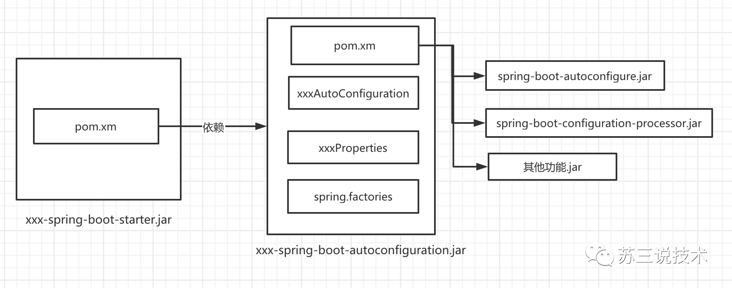
那麼,編寫starter需要哪些步驟?
- 1.需要定義一個名稱為xxx-spring-boot-starter的空專案,裡面不包含任何程式碼,可以有pom.xml和pom.properties檔案。
- 2.pom.xml檔案中包含了名稱為xxx-spring-boot-autoconfigure的專案。
- 3.xxx-spring-boot-autoconfigure專案中包含了名稱為xxxAutoConfiguration的類,該類可以定義一些bean範例。當然,Configuration類上可以打一些如:ConditionalOnClass、ConditionalOnBean、EnableConfigurationProperties等註解。
- 4.需要在spring.factories檔案中增加key為EnableAutoConfiguration,value為xxxAutoConfiguration。
我們試著按照這四步,自己編寫一個starter看看能否成功,驗證一下總結的內容是否正確。
3 如何定義自己的starter?
3.1 先建立一個空專案
該專案名稱為id-generate-starter,注意為了方便我把專案重新命名了,原本應該是叫id-generate-spring-boot-starter的,如下圖所示:
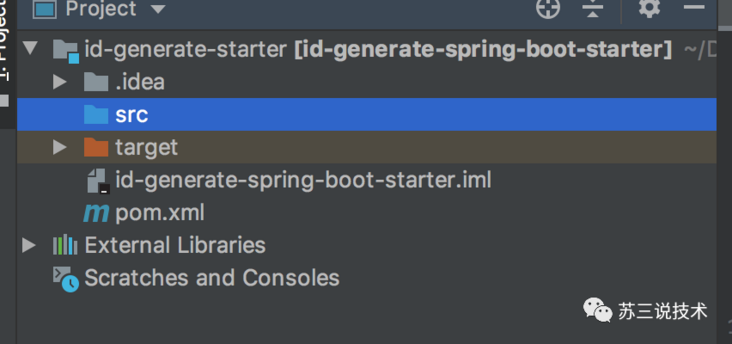
pom.xml檔案定義如下:
<?xml version="1.0" encoding="UTF-8"?>
<project xmlns="http://maven.apache.org/POM/4.0.0" xmlns:xsi="http://www.w3.org/2001/XMLSchema-instance" xsi:schemaLocation="http://maven.apache.org/POM/4.0.0 http://maven.apache.org/xsd/maven-4.0.0.xsd">
<modelVersion>4.0.0</modelVersion>
<version>1.3.1</version>
<groupId>com.sue</groupId>
<artifactId>id-generate-spring-boot-starter</artifactId>
<name>id-generate-spring-boot-starter</name>
<dependencies>
<dependency>
<groupId>com.sue</groupId>
<artifactId>id-generate-spring-boot-autoconfigure</artifactId>
<version>1.3.1</version>
</dependency>
</dependencies>
</project>
我們看到,它只引入了id-generate-spring-boot-autoconfigure。當然如果有需要這裡還可以引入多個autoconfigure或者多個其他jar包或者。
3.2 建立id-generate-autoconfigure
同樣為了方便我把專案重新命名了,原本是叫id-generate-spring-boot-autoconfigure,如下圖所示:

該專案當中包含:pom.xml、spring.factories、IdGenerateAutoConfiguration、IdGenerateService 和 IdProperties 這5個關鍵檔案,下面我們逐一看看。
先從pom.xml
<?xml version="1.0" encoding="UTF-8"?>
<project xmlns="http://maven.apache.org/POM/4.0.0" xmlns:xsi="http://www.w3.org/2001/XMLSchema-instance" xsi:schemaLocation="http://maven.apache.org/POM/4.0.0 http://maven.apache.org/xsd/maven-4.0.0.xsd">
<parent>
<groupId>org.springframework.boot</groupId>
<artifactId>spring-boot-starter-parent</artifactId>
<version>2.0.4.RELEASE</version>
</parent>
<modelVersion>4.0.0</modelVersion>
<version>1.3.1</version>
<groupId>com.sue</groupId>
<artifactId>id-generate-spring-boot-autoconfigure</artifactId>
<name>id-generate-spring-boot-autoconfigure</name>
<dependencies>
<dependency>
<groupId>org.springframework.boot</groupId>
<artifactId>spring-boot-starter</artifactId>
</dependency>
<dependency>
<groupId>org.springframework.boot</groupId>
<artifactId>spring-boot-autoconfigure</artifactId>
</dependency>
<dependency>
<groupId>org.springframework.boot</groupId>
<artifactId>spring-boot-configuration-processor</artifactId>
<optional>true</optional>
</dependency>
</dependencies>
<build>
<plugins>
<plugin>
<groupId>org.apache.maven.plugins</groupId>
<artifactId>maven-compiler-plugin</artifactId>
<configuration>
<source>1.8</source>
<target>1.8</target>
</configuration>
</plugin>
</plugins>
</build>
</project>
我們可以看到,這個檔案比較簡單就引入了:
- spring-boot-starter:springboot的相關jar包。
- spring-boot-autoconfigure:springboot自動設定相關jar包。
- spring-boot-configuration-processor:springboot生成IDE提示功能相關jar包。
重點看看spring.factories檔案:
org.springframework.boot.autoconfigure.EnableAutoConfiguration=com.sue.IdGenerateAutoConfiguration
它裡面只包含一行設定,其中key是EnableAutoConfiguration,value是IdGenerateAutoConfiguration。
再重點看一下IdGenerateAutoConfiguration
@ConditionalOnClass(IdProperties.class)
@EnableConfigurationProperties(IdProperties.class)
@Configuration
public class IdGenerateAutoConfiguration {
@Autowired
private IdProperties properties;
@Bean
public IdGenerateService idGenerateService() {
return new IdGenerateService(properties.getWorkId());
}
}
該類是一個使用了@Configuration註解標記為了設定類,生效的條件是@ConditionalOnClass註解中檢測到包含IdProperties.class。並且使用@EnableConfigurationProperties註解會自動注入IdProperties的範例。
此外,最關鍵的點是該類裡面建立了idGenerateService的bean範例,這是自動設定的精髓。
再看看IdGenerateService
public class IdGenerateService {
private Long workId;
public IdGenerateService(Long workId) {
this.workId = workId;
}
public Long generate() {
return new Random().nextInt(100) + this.workId;
}
}
我們可以看到它是一個普通的類,甚至都沒有使用@Service註解,裡面有個generate方法,根據workId的值和亂數動態生成id。
最後看看IdProperties
@ConfigurationProperties(prefix = IdProperties.PREFIX)
public class IdProperties {
public static final String PREFIX = "sue";
private Long workId;
public Long getWorkId() {
return workId;
}
public void setWorkId(Long workId) {
this.workId = workId;
}
}
它是一個設定實體類,裡面包含了相關的組態檔。使用@ConfigurationProperties註解,會自動把application.properties檔案中以sue開通的,引數名稱跟IdProperties中一樣的引數值,自動注入到IdProperties物件中。
3.3 建立id-generate-test
這個專案主要用於測試。
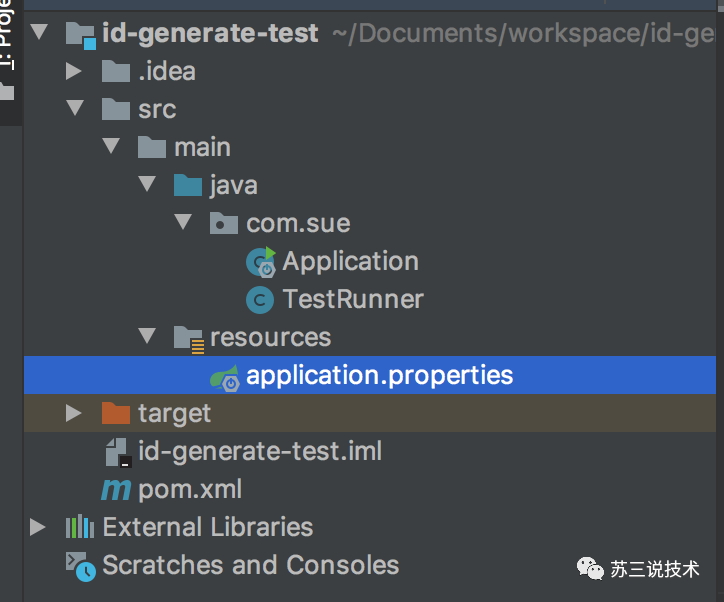
該專案裡面包含:pom.xml、application.properties、Application 和 TestRunner 檔案。
先看看pom.xml檔案
<?xml version="1.0" encoding="UTF-8"?>
<project xmlns="http://maven.apache.org/POM/4.0.0" xmlns:xsi="http://www.w3.org/2001/XMLSchema-instance" xsi:schemaLocation="http://maven.apache.org/POM/4.0.0 http://maven.apache.org/xsd/maven-4.0.0.xsd">
<modelVersion>4.0.0</modelVersion>
<version>1.3.1</version>
<groupId>com.sue</groupId>
<artifactId>spring-boot-id-generate-test</artifactId>
<name>spring-boot-id-generate-test</name>
<dependencies>
<dependency>
<groupId>com.sue</groupId>
<artifactId>id-generate-spring-boot-starter</artifactId>
<version>1.3.1</version>
</dependency>
</dependencies>
</project>
由於只測試剛剛定義的id生成功能,所以只引入的id-generate-spring-boot-starter jar包。
application.properties設定資原始檔
sue.workId=123
只有一行設定,因為我們的IdProperties中目前只需要這一個引數。
Application是測試程式啟動類
@SpringBootApplication
public class Application {
public static void main(String[] args) {
SpringApplication.run(Application.class, args);
}
}
很簡單,就是一個普通的springboot啟動類
TestRunner是我們的測試類
@Component
public class TestRunner implements ApplicationRunner {
@Autowired
private IdGenerateService idGenerateService;
public void run(ApplicationArguments args) throws Exception {
Long sysNo = idGenerateService.generate();
System.out.println(sysNo);
}
}
它實現了ApplicationRunner介面,所以在springboot啟動的時候會呼叫該類的run方法。
好了,所有自定義starter的程式碼和測試程式碼都已經就緒。接下,執行一下Application類的main方法。
執行結果:
176
完美,驗證成功了。
接下來,我們分析一下starter的底層實現原理。
4 starter的底層原理是什麼?
通過上面編寫自己的starter的例子,相信大家對starter的認識更進一步了,現在跟大家一起看看starter的底層是如何實現的。
id-generate-starter.jar其實是一個空專案,依賴於id-generate-autoconfiguration.jar。
id-generate-starter.jar是一個入口,我們給他取一個更優雅的名字:門面模式,其他業務系統想引入相應的功能,必須要通過這個門面。
我們重點分析一下 id-generate-autoconfiguration.jar
該jar包核心內容是:IdGenerateConfiguration,這個設定類中建立了IdGenerateService物件,IdGenerateService是我們所需要自動設定的具體功能。
接下來一個最重要的問題:
IdGenerateConfiguration為什麼會自動載入的呢?
還記得我們定義的spring.factories檔案不?
org.springframework.boot.autoconfigure.EnableAutoConfiguration=com.sue.IdGenerateAutoConfiguration
它裡面只包含一行設定,其中key是EnableAutoConfiguration,value是IdGenerateAutoConfiguration。
要搞明白這個過程,要從Application類的@SpringBootApplication註解開始:
@Target(ElementType.TYPE)
@Retention(RetentionPolicy.RUNTIME)
@Documented
@Inherited
@SpringBootConfiguration
@EnableAutoConfiguration
@ComponentScan(excludeFilters = {
@Filter(type = FilterType.CUSTOM, classes = TypeExcludeFilter.class),
@Filter(type = FilterType.CUSTOM, classes = AutoConfigurationExcludeFilter.class) })
public @interface SpringBootApplication {
@AliasFor(annotation = EnableAutoConfiguration.class)
Class<?>[] exclude() default {};
@AliasFor(annotation = EnableAutoConfiguration.class)
String[] excludeName() default {};
@AliasFor(annotation = ComponentScan.class, attribute = "basePackages")
String[] scanBasePackages() default {};
@AliasFor(annotation = ComponentScan.class, attribute = "basePackageClasses")
Class<?>[] scanBasePackageClasses() default {};
}
從上面可以看出該註解裡面包含了@EnableAutoConfiguration註解。
@Target(ElementType.TYPE)
@Retention(RetentionPolicy.RUNTIME)
@Documented
@Inherited
@AutoConfigurationPackage
@Import(AutoConfigurationImportSelector.class)
public @interface EnableAutoConfiguration {
String ENABLED_OVERRIDE_PROPERTY = "spring.boot.enableautoconfiguration";
Class<?>[] exclude() default {};
String[] excludeName() default {};
}
@EnableAutoConfiguration註解會引入AutoConfigurationImportSelector類。
該類的selectImports方法一個關鍵方法:
@Override
public String[] selectImports(AnnotationMetadata annotationMetadata) {
//設定有沒有設定spring.boot.enableautoconfiguration開關,預設為true
//如果為false,則不執行自動設定的功能,直接返回
if (!isEnabled(annotationMetadata)) {
return NO_IMPORTS;
}
//找spring-autoconfigure-metadata.properties中的元素
AutoConfigurationMetadata autoConfigurationMetadata = AutoConfigurationMetadataLoader
.loadMetadata(this.beanClassLoader);
//獲取EnableAutoConfiguration註解中的屬性
AnnotationAttributes attributes = getAttributes(annotationMetadata);
//獲取工程下所有設定key為EnableAutoConfiguration的值,即IdGenerateConfiguration等類。
List<String> configurations = getCandidateConfigurations(annotationMetadata,
attributes);
//刪除重複的值
configurations = removeDuplicates(configurations);
//獲取需要排除的規則列表
Set<String> exclusions = getExclusions(annotationMetadata, attributes);
//檢查
checkExcludedClasses(configurations, exclusions);
//刪除需要排除的值
configurations.removeAll(exclusions);
//根據組態檔中設定的開關,過濾一部分不滿足條件的值
configurations = filter(configurations, autoConfigurationMetadata);
fireAutoConfigurationImportEvents(configurations, exclusions);
return StringUtils.toStringArray(configurations);
}
這裡就是starter能夠自動設定的祕密。
此外,有些朋友看其他人定義的springboot starter可能會有疑惑。
先看看druid-spring-boot-starter
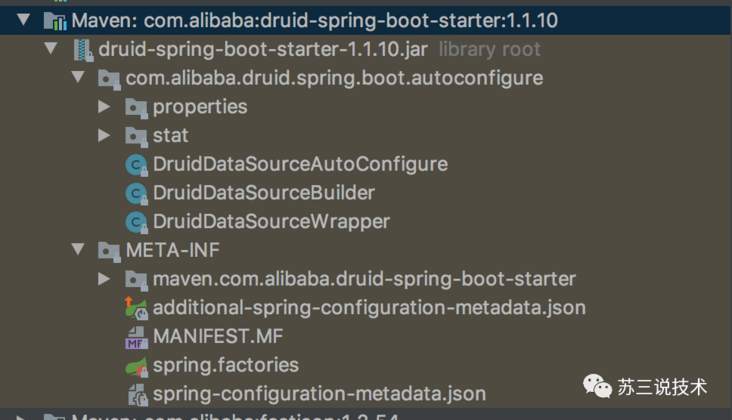
alibaba定義的druid-spring-boot-starter只有xxx-spring-boot-starter.jar檔案,而沒有xxx-spring-boot-autoconfigure.jar檔案。
再看看spring-boot-starter-jdbc:

更神奇的是這個檔案中連pom.xml都沒有,一臉懵逼。。。。。。。
是不是我講錯了?
答:其實沒有。
SpringBoot的原則是約定優於設定。
從spring-boot-starter-jdbc內部空實現來看,它的約定是要把xxx-spring-boot-starter.jar和xxx-spring-boot-autoconfigure.jar區分開的。個人認為,alibaba定義得並不好,沒有遵照springboot的約定,雖然功能不受影響。(這個地方歡迎一起探討一下)
而springboot自己定義的spring-boot-starter-jdbc為什麼連pom.xml檔案也沒有呢?
它不需要依賴xxx-spring-boot-autoconfigure.jar檔案嗎?
因為springboot把所有的自動設定的類都統一放到spring-boot-autoconfigure.jar下面了:
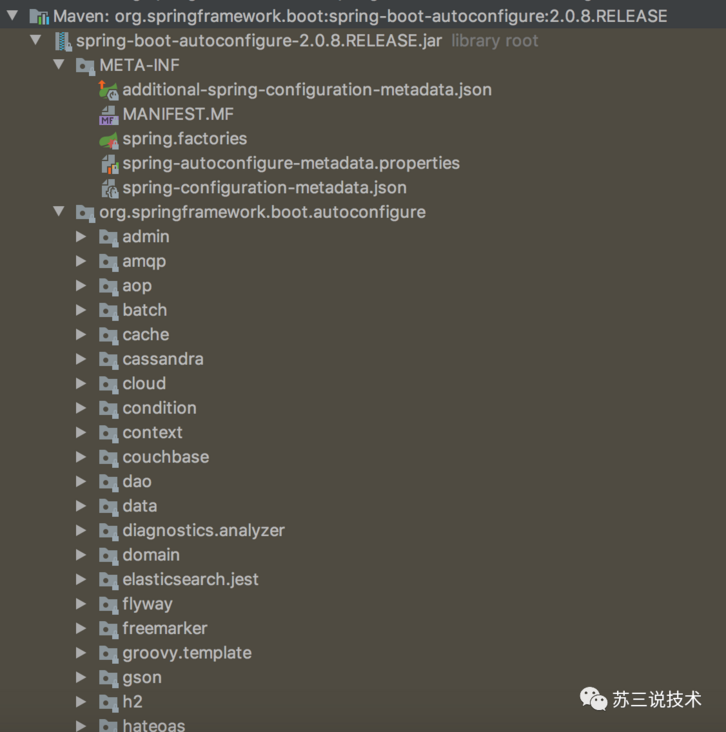
spring.factories檔案內容如下:
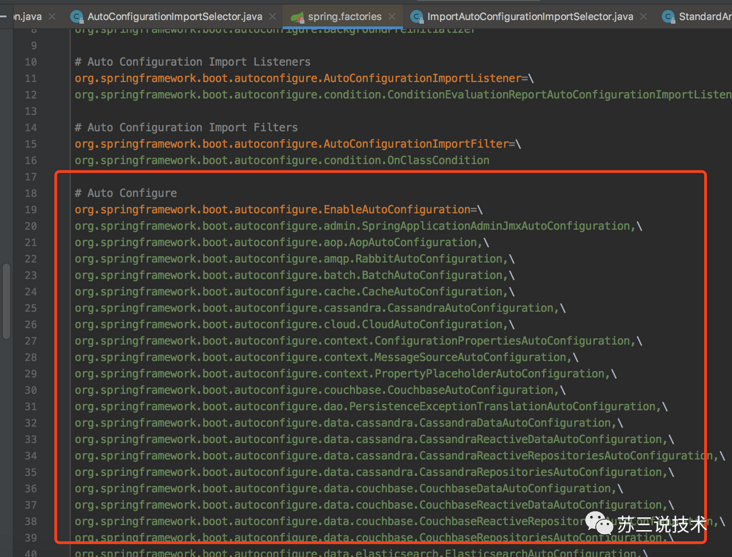
SpringBoot這樣集中管理自動設定,而不需要從各個子包中遍歷,我個人認為是為了查詢效率。
我們最後再看看spring-cloud-starter-openfegin

明顯看到,它是遵循了我們說的原則的。
除此之外,還有一個原則一順便提一下。
SpringBoot和SpringCloud系列定義jar包的名稱是:
- spring-boot-starter-xxx.jar
- spring-cloud-starter-xxx.jar
而我們自己的專案定義的jar應該是:
- xxx-spring-boot-starter.jar
最後說一句(求關注,別白嫖我)
如果這篇文章對您有所幫助,或者有所啟發的話,幫忙掃描下發二維條碼關注一下,您的支援是我堅持寫作最大的動力。
求一鍵三連:點贊、轉發、在看。
關注公眾號:【蘇三說技術】,在公眾號中回覆:面試、程式碼神器、開發手冊、時間管理有超讚的粉絲福利,另外回覆:加群,可以跟很多BAT大廠的前輩交流和學習。